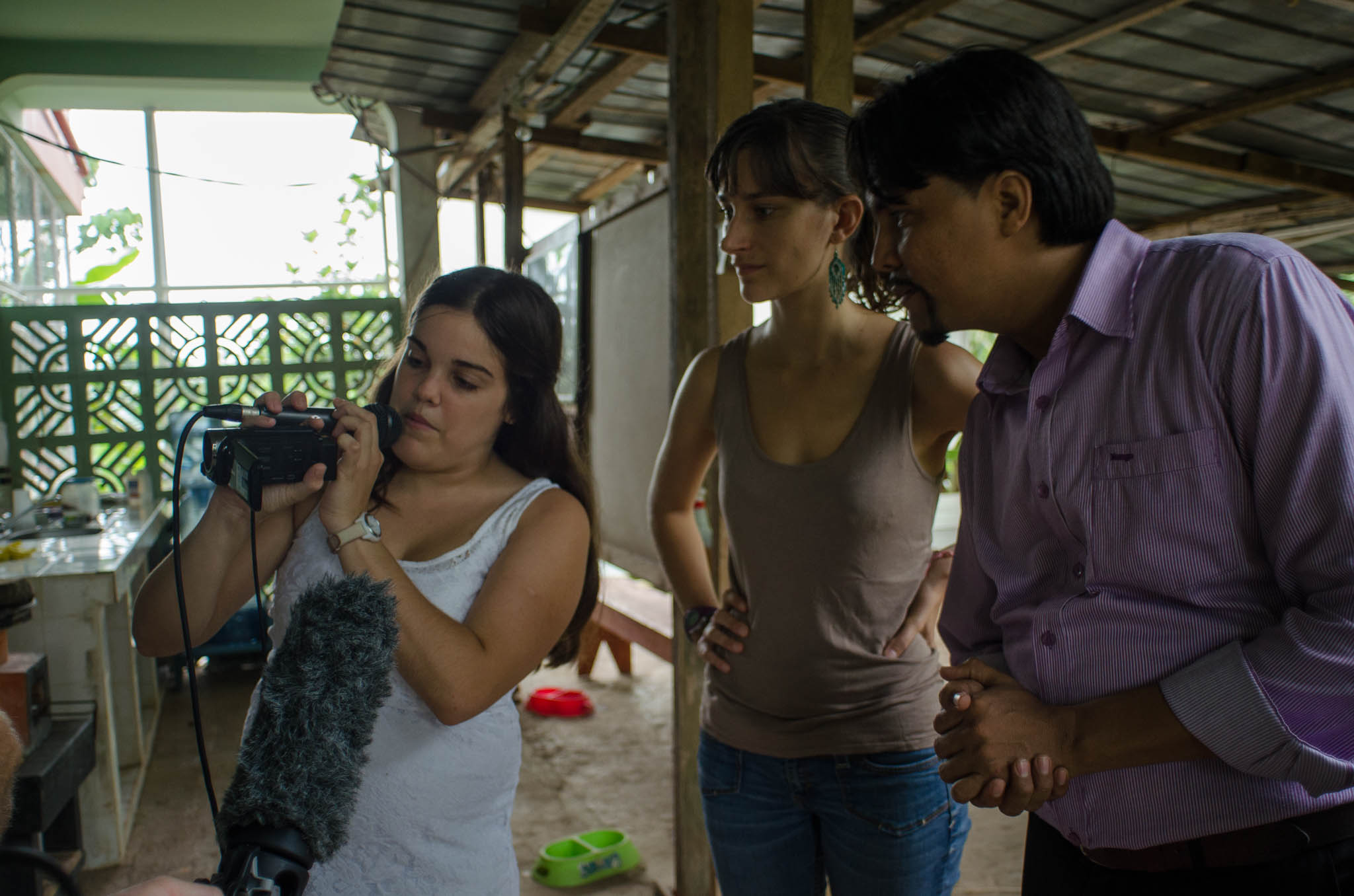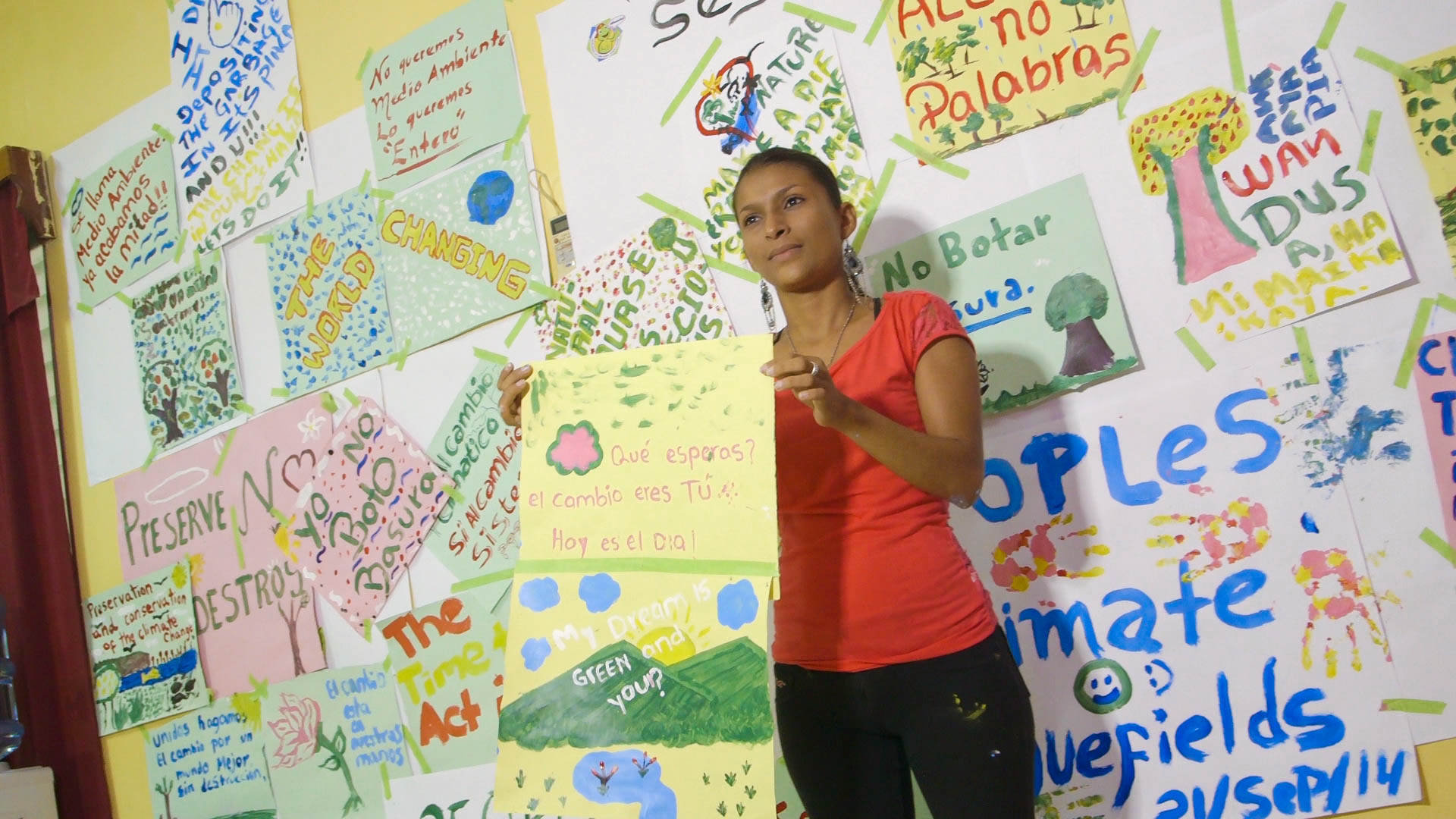By Tom Miller
Arrival in Managuai - vdeo still, Tom Miller
OPOE arrived in Managua, Nicaragua on Tuesday evening, September 16th. We arrived in the middle of the rainy season and as we stepped out of the airport the night was damp and hot. We were met by Mario, our driver for the evening, and an employee of the non-profit organization blueEnergy, our host for the first leg of our trip. We spent one night in Managua before continuing on the following morning to Bluefields, the capital of the Southern Autonomous region and the home-base of blueEnergy in Nicaragua.
Through our foggy windows in the car we caught glimpses of Managua: florescent lights poured from open-air bars and restaurants; figures moved, silhouetted starkly against colorful walls; and giant wonderland sculptures – neon trees, lit with hundreds of bulbs – hung over the road, obscuring, albeit momentarily, the poverty behind them.
Trees of Life, Managua
We were told later that these sculptures are know as “Trees of Life” and were designed by current President Daniel Ortega’s wife, Rosario Murillo, in commemoration of the Sandinista revolution. But critics claim the trees (each of them costing $20,000 US) are a gaudy reminder of the more than 70 years of self-enrichment by Nicaragua’s political leadership and meddling by foreign powers which has kept Nicaragua the second poorest country in the hemisphere.
Unlike the Caribbean countries we visited in July and August, Nicaragua has noticeably more poverty, with 46% of the population living on $1.17 (US) a day or less. In the Atlantic region, the poverty rate for rural communities is upwards of 75% of the population living on or under $1.17 (the majority of the population on the Atlantic coast is rural). And because many of these are traditional indigenous communities who practice subsistence living, they are particularly vulnerable to changes in fish populations, arable land, changes in climate, etc., and have no additional sources of income to fall back on. In addition, as we would soon come to discover, these communities are also threatened by a potential trans-oceanic canal project that would cut a 250km swatch across Nicaragua, displacing over 200 villages and creating environmental havoc. Although many of these villages are in the Southern Autonomous region - where indigenous tribes have autonomy over the land and resources - quiet deals between the Hong Kong development company and President Ortega, and a quick change to the Nicaraguan constitution, make development of the canal all the more likely.
*
Stephen Kinzer's book, Blood of Brothers
In our room at the Managua blueEnergy compound, someone had left behind the book Blood of Brothers: Life and War in Nicaragua and I began reading the opening chapter. The author, Stephen Kinzer, arrived in Managua as a young journalist in 1976. Much of the city was still in ruins after a devastating earthquake four years earlier that left 20,000 injured and over 250,000 inhabitants homeless, and as Kinzer quickly discovered, the country was also on the brink of revolution. By 1979, Sandinista revolutionaries had overthrown the Somoza dynasty and taken control of the country, and by 1980, Reagan and the US were funneling money and weapons to the conservative Contra guerillas which fueled a civil war that cost over 30,000 Nicaraguan lives. I fell asleep that evening considering how little I really knew about Nicaragua, and wondering what - now 30 years on - had changed after all those years of conflict.
Nuin-Tara gets wind-blown in the panga - still, Tom
The following morning we took a 5 hour bus ride to the town of Rama and from there, on to Bluefields. But because much of Nicaragua's infrastructure was destroyed during the Sandinista-Contra war, there is no "real" road to Bluefields and we - like most people in the area - took the 2 hour, very bumpy, panga (boat) trip down the Escondido River and into the Southern Atlantic Autonomous Region.
There are two autonomous regions in Nicaragua, the Región Autónoma del Atlántico Sur (R.A.A.S.) and the Región Autónoma del Atlántico Norte (R.A.A.N.). Both regions contain indigenous populations of Miskitos, Ulwa, and Kukra. And in the R.A.A.S. there are also the Rama people. (More on the Rama in next week's blog.) These autonomous regions have enabled many of these communities to maintain their ancestral languages and traditional practices. Although the communities in these regions have exclusive rights over their territories, we have heard many times about the challenges they face in maintaining their rights, on the ground. The regional government (The Rama-Kriol Territorial Government - GTRK) is relatively new and faces many challenges with representing such a diverse population in a complex setting.
Downtown Bluefields - video still, Tom Miller
The following morning was the first of a three-day low-cost video workshop with volunteers from blueEnergy. Because blueEnergy is currently developing their own video about traditional fishing and agricultural practices in the coastal village of Bangkukuk, we tailored this workshop around how to develop a storyline using storyboards, how to shoot creatively and efficiently with different shot-types and journalistic methods, and how to plan and approach a multi-day shoot with b-rolls, interviews, additional audio, and still photography.
In one of the workshop exercises, the participants designed and filmed a quick video about composting on the blueEnergy compound. Their task was to use the various shot-types we covered (close-up, wide shot, medium shot, etc.) to develop and draw their concept as a storyboard, then go out and film. Their short video can be seen on the right.
On Sunday, OPOE participated in a People's Climate March (PCM) event coordinated by blueEnergy and other local partners at Bluefields Indian and Caribbean University (BICU). As it was, the event was the only People's Climate March event held in Nicaragua and OPOE was honored to be included both in the event and on the banner alongside the other participating groups. (See right)
The event banner made by a local artist. - photo, Tom Miller
The artist (right) delivers the event banner to blueEnergy - Still, Tom Miller
Banner at Bluefields Indian and Caribbean University, "Acciones, no Palabras" - "Actions, not Words" - Still, Tom Miller
The event began with participants painting posters with personal messages related to climate change, the movement, and different actions they are taking in their own communities. Even though many participants were shy, with a little coaxing they explained their posters to OPOE's camera and posed for photos in front of a rapidly expanding and colorful wall of vibrant messages of hope and change. After this activity, we then settled in with some popcorn to watch the documentary Disruption and for a Q&A (with prizes).
Worldwide, the People's Climate March brought in 2,646 groups in 162 countries. New York city saw 400,000 people take to the streets demanding change and action. This type of engagement is critical to the buildup to the 2015 UN Climate Change Conference in Paris. The turnout to the People's Climate March is a good step toward getting people and communities to take action.
*
When it comes to our changing climate, we do need a giant leap forward - right now. This leap can often seem overwhelming and beyond our control, but we need to remember that the little steps are just as important. Change needs to come at all levels, from all directions.
¿Que Podemos Hacer Juntos? What can we do together?
"Que podemos hacer juntos"? What can we do together? Sign at the People's Climate March Bluefields event - photo, Tom Miller
Check out our entire archive below...
-
July 2016
- Jul 12, 2016 New Video: Puruvesi (Ice fishing in Finland) Jul 12, 2016
-
March 2016
- Mar 5, 2016 Puruvesi Mar 5, 2016
-
July 2015
- Jul 14, 2015 Almost, Exactly Average or: How I Stopped Worrying and Started to Love Crowdfunding Jul 14, 2015
- Jul 8, 2015 Summer on the Jukajoki Jul 8, 2015
-
May 2015
- May 18, 2015 What are they building in there? May 18, 2015
- May 7, 2015 No Silver Bullet: Ecomodernism, Technology, and Path Dependency May 7, 2015
-
November 2014
- Nov 11, 2014 Some Fish, Some Tango, and a Fiery Goodbye Nov 11, 2014
-
October 2014
- Oct 26, 2014 62° 39' 00" N, 30° 08' 00" E Oct 26, 2014
- Oct 14, 2014 Bluefields to Wawashang - Final Nicaragua Installment Oct 14, 2014
- Oct 3, 2014 Monkey Point & Bangkukuk: Part 2 Oct 3, 2014
- Oct 1, 2014 Monkey Point & Bangkukuk: Part 1 Oct 1, 2014
-
September 2014
- Sep 30, 2014 ¿Que Podemos Hacer Juntos? (What Can We Do Together?) Sep 30, 2014
- Sep 11, 2014 Reflections on Union and a Brief Respite with Cosmos Sep 11, 2014
- Sep 2, 2014 The Sea Will Rise, Barbuda Will Survive Sep 2, 2014
-
August 2014
- Aug 25, 2014 OPOE in Antigua or, Tarantulas, LambLions & Plumeria Aug 25, 2014
- Aug 24, 2014 A Farwell to Union, Hello Grenada Aug 24, 2014
- Aug 10, 2014 I'll Have One Film Workshop, With a Side of Chicken Fever Aug 10, 2014
- Aug 4, 2014 Island Hopping - from Bequia to Union Aug 4, 2014
-
July 2014
- Jul 30, 2014 A Sub, a Princess, Chicken and Bake - Another OPOE Week in Review Jul 30, 2014
- Jul 20, 2014 From Santa Fe to St. Vincent - OPOE's First Week in the Field Jul 20, 2014
-
May 2014
- May 30, 2014 Fast Tracking Climate Adaptation–tapping our natural tendency to experiment May 30, 2014
- May 21, 2014 Reframing Despair May 21, 2014
- May 8, 2014 May 13th Campaign Launch! Help Build Momentum May 8, 2014
- May 5, 2014 Update - letter of support from USAID! May 5, 2014
-
April 2014
- Apr 11, 2014 Project Launch! Apr 11, 2014
- Apr 10, 2014 Climate CoLab Submission Apr 10, 2014



































